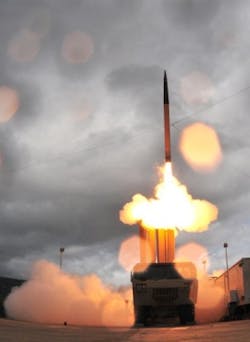Lockheed Martin to build 48 infrared-guided THAAD anti-ballistic-missile weapons in $695 million contract
Each THAAD battery is to have 24 missiles -- three launchers and a fire control communications system, including an X-Band radar. The 18-foot-long THAAD missile weighs 1,400 pounds, and has a range of 125 miles.
Powering each THAAD missile is a single-stage solid-propellant rocket motor with thrust vectoring. After burnout, the booster separates from the missile's kill vehicle, and the kill vehicle continues to its incoming ballistic missile target. THAAD missiles can function inside or outside of Earth's atmosphere.
Guiding the kill vehicle section of the THAAD missile is an indium antimonide staring infrared focal plane array sensor. The kill vehicle itself has no explosive warhead and destroys the target by direct impact.
Lockheed Martin got its first contract to produce the first 48 THAAD missiles and support equipment in 2007. Lockheed Martin will manage work on the latest batch of 48 missiles in Sunnyvale, Calif., and will do final assembly in Troy, Ala.
For more information contact Lockheed Martin Space Systems Co. online at www.lockheedmartin.com/ssc, or the Missile Defense Agency at www.mda.mil.
